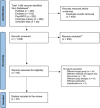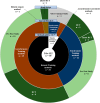Current status of Tele-speech language therapy by type and support for patients with post-stroke aphasia: A scoping review
- PMID: 40132018
- PMCID: PMC11936174
- DOI: 10.1371/journal.pone.0319805
Current status of Tele-speech language therapy by type and support for patients with post-stroke aphasia: A scoping review
Abstract
Purpose: The purpose of this study was to classify and analyze trends in the assessment and training methods used in telepractice speech-language therapy (Tele-SLT) for people with aphasia (PWA), according to the type of Tele-SLT (synchronous, asynchronous, or combined). This study particularly aimed to identify gaps that prevent the establishment of Tele-SLT, a field that has gained significant attention post-COVID-19 pandemic.
Design: A scoping review was conducted following the PRISMA-ScR guidelines.
Setting and participants: Included were research articles on Tele-SLT for individuals aged 18 years or older diagnosed with post-stroke aphasia. Articles in both English and Japanese were reviewed, using five online databases (Medline, Embase, PsycInfo, Cochrane Library, and ICHUSHI Web).
Methods: Studies involving Tele-SLT were categorized by support methods, content, study design, and outcomes. The quality of the extracted studies was also assessed. We also assessed the quality of the selected studies and performed a meta-analysis of some of the results.
Results: Of the initial 1,484 articles, 35 met the eligibility criteria. Regarding Tele-SLT support methods, 3 articles (8.57%) focused on assessment methods, while 32 (91.43%) focused on training methods. Fourteen articles (40.00%) employed synchronous Tele-SLT delivery, 20 (57.14%) employed asynchronous delivery, and 1 (2.86%) employed a combined approach. The methodological quality of 27 (77.14%) of the included Tele-SLT articles was rated as 'Low'. A meta-analysis of randomized controlled trials on Tele-SLT demonstrated that asynchronous training was effective for language function.
Conclusions and significance: This study highlights the need for more research, particularly on remote assessment and synchronous training methods, in Tele-SLT for PWA. Furthermore, this study emphasizes the need for improved research methodologies in this area. To provide high-quality support for PWA who have faced challenges accessing in-person speech-language therapy since the COVID-19 pandemic, further research and development of Tele-SLT implementation guidelines are needed.
Copyright: © 2025 Kodani et al. This is an open access article distributed under the terms of the Creative Commons Attribution License, which permits unrestricted use, distribution, and reproduction in any medium, provided the original author and source are credited.
Conflict of interest statement
The authors declare that there is no conflict of interest.
Figures






Similar articles
-
Experiences and perspectives of UK speech and language therapists on telehealth assessment with people living with post-stroke aphasia.Int J Lang Commun Disord. 2025 Mar-Apr;60(2):e70018. doi: 10.1111/1460-6984.70018. Int J Lang Commun Disord. 2025. PMID: 39987559 Free PMC article.
-
Supporting people with post-stroke aphasia to live well: A cross-sectional survey of Speech & Language Therapists in Ireland.Health Soc Care Community. 2020 Nov;28(6):2105-2116. doi: 10.1111/hsc.13021. Epub 2020 May 27. Health Soc Care Community. 2020. PMID: 32462685
-
Attention control comparisons with SLT for people with aphasia following stroke: methodological concerns raised following a systematic review.Clin Rehabil. 2018 Oct;32(10):1383-1395. doi: 10.1177/0269215518780487. Epub 2018 Jun 17. Clin Rehabil. 2018. PMID: 29911416
-
Telehealth in speech and language therapy during the COVID-19 pandemic: a systematic review.Disabil Rehabil Assist Technol. 2024 Apr;19(3):761-768. doi: 10.1080/17483107.2022.2122605. Epub 2022 Sep 21. Disabil Rehabil Assist Technol. 2024. PMID: 36129435
-
An update on medications and noninvasive brain stimulation to augment language rehabilitation in post-stroke aphasia.Expert Rev Neurother. 2017 Nov;17(11):1091-1107. doi: 10.1080/14737175.2017.1373020. Epub 2017 Sep 8. Expert Rev Neurother. 2017. PMID: 28847186 Review.
Cited by
-
ORLA combined with telerehabilitation in patients with subacute Poststroke aphasia: a randomized controlled trial.Sci Rep. 2025 Jul 1;15(1):22193. doi: 10.1038/s41598-025-06258-5. Sci Rep. 2025. PMID: 40596208 Free PMC article. Clinical Trial.
References
-
- Goldstein LB, Adams R, Alberts MJ, Appel LJ, Brass LM, Bushnell CD, et al.. Primary prevention of ischemic stroke: a guideline from the American Heart Association/American Stroke Association Stroke Council: cosponsored by the Atherosclerotic Peripheral Vascular Disease Interdisciplinary Working Group; Cardiovascular Nursing Council; Clinical Cardiology Council; Nutrition, Physical Activity, and Metabolism Council; and the Quality of Care and Outcomes Research Interdisciplinary Working Group: the American Academy of Neurology affirms the value of this guideline. Stroke. 2006;37(6):1583–633. doi: 10.1161/01.STR.0000223048.70103.F1 - DOI - PubMed
-
- Warlow CP, Van Gijn J, Dennis MS, Wardlaw JM, Bamford JM, Hankey GJ, et al.. Stroke: practical management. 3rd ed. Oxford: John Wiley & Sons; 2008.
-
- Wallace S, Worrall L, Rose T, Le Dorze G. Using the international classification of functioning, disability, and health to identify outcome domains for a core outcome set for aphasia: a comparison of stakeholder perspectives. Disability and Rehabilitation. 2019;41:564–73. - PubMed
Publication types
MeSH terms
LinkOut - more resources
Full Text Sources
Medical
Miscellaneous

